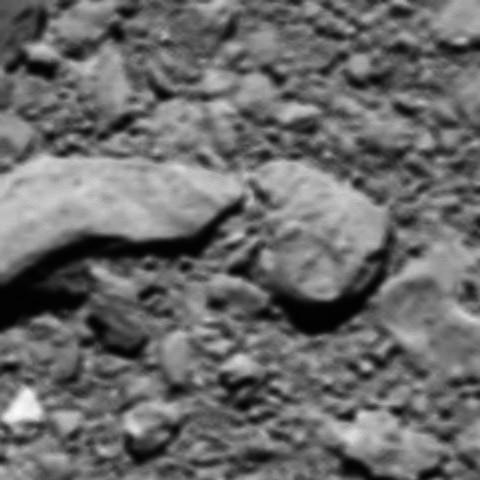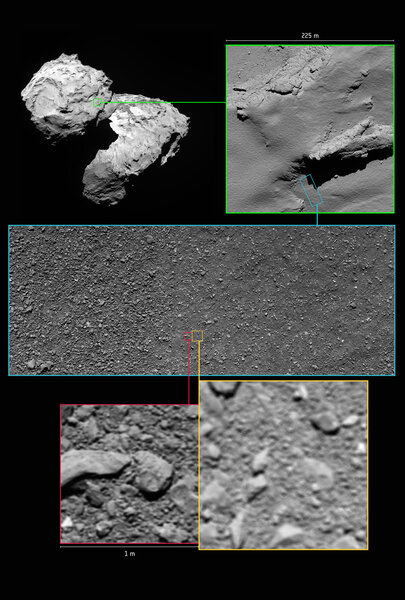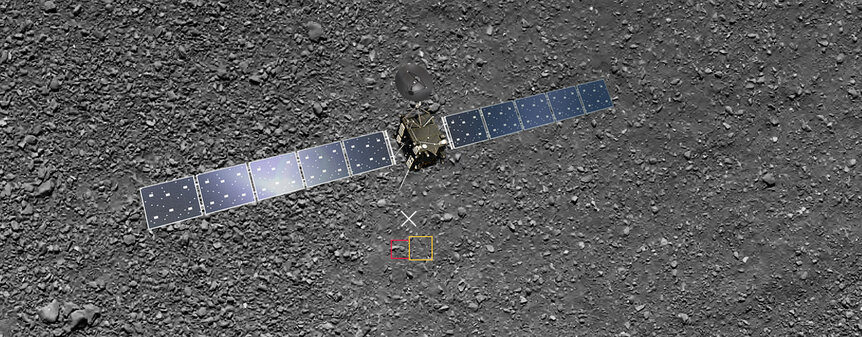Create a free profile to get unlimited access to exclusive videos, sweepstakes, and more!
A last good bye, again, from Rosetta
Just over a year ago, the Rosetta spacecraft performed its last act: setting itself down gently on the surface of a comet. It was the culmination of an adventure that launched in 2004 and began in earnest in 2014 when the spacecraft first approached the comet 67/P Churyumov-Gerasimenko.
For two years, the spacecraft orbited 67P, taking incredible photos and data that changed what we understood about these icy visitors. But all good things ... on September 30, 2016, the mission came to end. Rosetta approached the comet, drawing ever nearer, snapping images on the way down. When it was 25 meters above the surface, just before touching down on the surface, it took one last image and sent it back to Earth.
… or did it?
Well, no. That was actually the penultimate image, the second-to-last shot. Rosetta actually took another one when it was just 19 meters (62 feet) above the surface. That image was in the process of being sent back to Earth when the spacecraft touched down on the comet and communication was cut off.
When the data got back here, the software that automatically processed it didn’t recognize it as an image, because only about half the data were transmitted. But almost a year later, engineers noticed the orphaned telemetry packets, realized what they had, and were able to reconstruct that truly last image from Rosetta!
This portrait of the comet’s surface shows an area about a meter across, with a resolution of about 2 millimeters per pixel. That means it barely resolves small pebbles. The part of the boomerang-shaped rock on the left we can see is about the size of, well, a decent boomerang (half a meter, or 18 inches, though part it is cut off on the left edge), and the rock next to it is about the size of an American football.
Due to the way the images were compressed and sent by the spacecraft, finer detail in the image was lost. But how’s this for attention to detail: In general, the OSIRIS camera on Rosetta was designed to take images from a few hundred meters away; when it gets too close, the images are out of focus. However, it was also designed to use filters that were arranged on a wheel (like slots on a roulette wheel), and those change the focus a little bit. By changing the setting to a blank slot with no filter, the camera had better focus at close range. It would’ve been perfect at 15 meters, and 19 meters is pretty close to that.
So, in fact, this image would’ve been the best focused image of the approach … had all the telemetry been received. Ah, well.
The European Space Agency put together this wonderful mosaic showing the final image in context:
The top image shows the entire rubber-ducky-shaped comet, with the landing site indicated and zoomed in the upper right. Rosetta landed in a shallow pit (running from the bottom center to the lower right), where ices under the surface had turned directly into a gas. This creates loose rubble that can roll even in the comet’s low gravity (or due to the extremely tenuous wind generated as that gas escapes).
The next image (middle), I believe, shows just that. You can see the left side has larger pebbles than on the right, which I suspect may be due to “gravitational sorting,” basically different sized pieces rolling downhill.
What we thought was the last image is shown at the bottom right, and the actual one on the left; they are adjacent on the surface.
And where did Rosetta land, exactly?
This image shows those two last images side-by-side, and the X marks the spot where Rosetta now rests. An image of the spacecraft has been superimposed on it just above to show the scale.
And this all makes me wonder … if the data were discovered months later, only partially transmitted to us humans over 700 million kilometers away, then is it possible other data like this from other missions may still be lurking on someone’s server somewhere?
Hmmmm.
But, for Rosetta, this really is it. The last shot we’ll get from the mission. It’s done.
But what about us? Well — if I may paraphrase Rick Blaine — we’ll always have 67/P Churyumov-Gerasimenko.





























